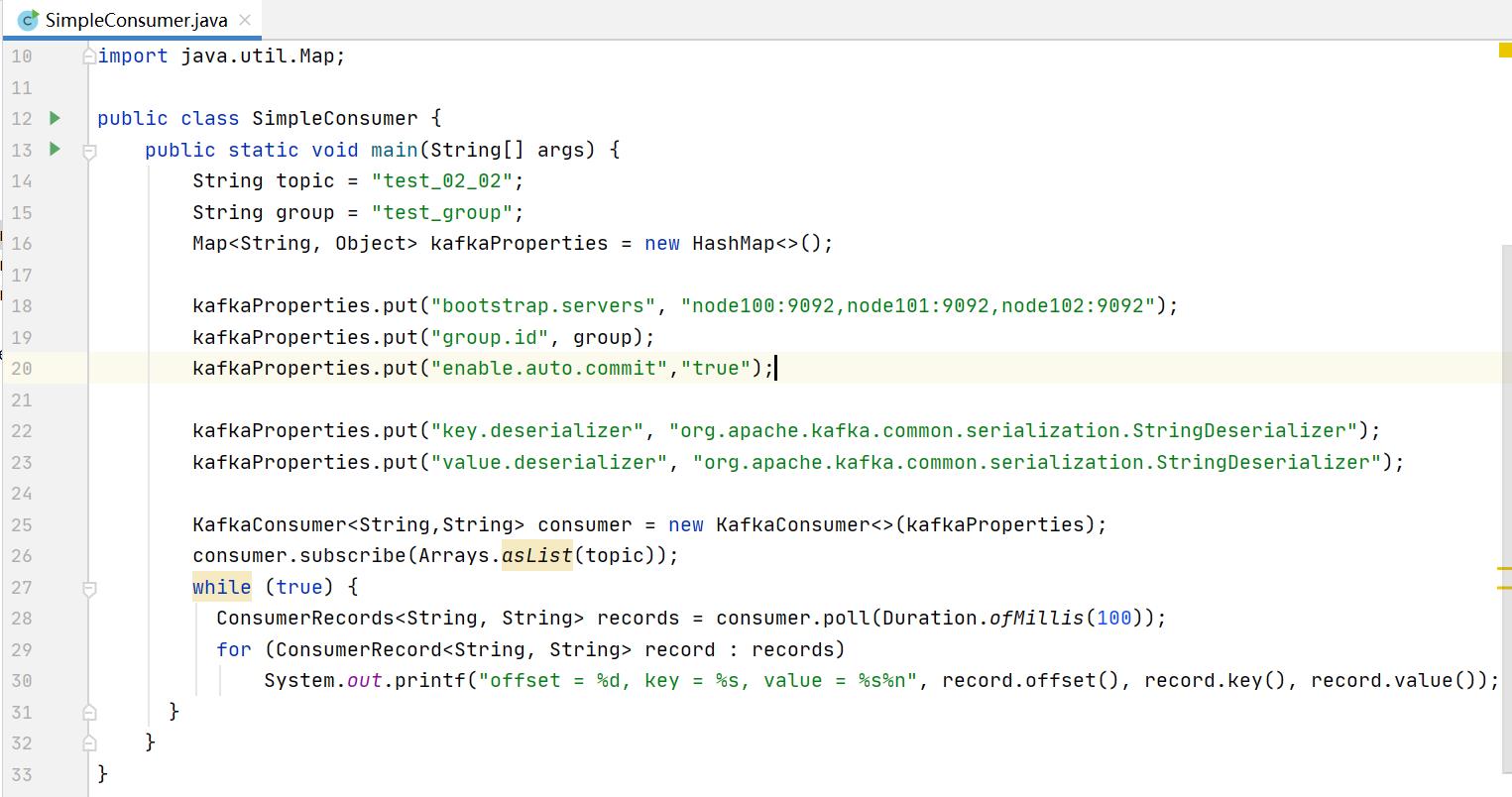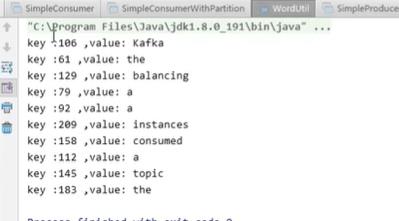学习笔记Kafka—— Kafka Consumer API及开发实例
Posted 别呀
tags:
篇首语:本文由小常识网(cha138.com)小编为大家整理,主要介绍了学习笔记Kafka—— Kafka Consumer API及开发实例相关的知识,希望对你有一定的参考价值。
一、Kafka Consumer API
1.1、Consumer

1.2、KafkaConsumer

1.3、ConsumerRecords

1.4、ConsumerRecord

1.5、KafkaConsumer 实战
package demo02;
import org.apache.kafka.clients.consumer.ConsumerRecord;
import org.apache.kafka.clients.consumer.ConsumerRecords;
import org.apache.kafka.clients.consumer.KafkaConsumer;
import java.time.Duration;
import java.util.Arrays;
import java.util.HashMap;
import java.util.Map;
public class SimpleConsumer
public static void main(String[] args)
String topic = "test_02_02";
String group = "test_group";
Map<String, Object> kafkaProperties = new HashMap<>();
kafkaProperties.put("bootstrap.servers", "node100:9092,node101:9092,node102:9092");
kafkaProperties.put("group.id", group);
kafkaProperties.put("enable.auto.commit","true");
kafkaProperties.put("key.deserializer", "org.apache.kafka.common.serialization.StringDeserializer");
kafkaProperties.put("value.deserializer", "org.apache.kafka.common.serialization.StringDeserializer");
KafkaConsumer<String,String> consumer = new KafkaConsumer<>(kafkaProperties);
consumer.subscribe(Arrays.asList(topic));
while (true)
ConsumerRecords<String, String> records = consumer.poll(Duration.ofMillis(100));
for (ConsumerRecord<String, String> record : records)
System.out.printf("offset = %d, key = %s, value = %s%n", record.offset(), record.key(), record.value());

结果:

二、Producer & Consumer整合实战
- 1、设计一个工具类可以返回随机字符串
WordUtil .java
package demo03;
import org.apache.kafka.common.protocol.types.Field;
import java.util.Random;
public class WordUtil
public static final String[] WORDS = "A traditional queue retains records in-order on the server, and if multiple consumers consume from the queue then the server hands out records in the order they are stored. However, although the server hands out records in order, the records are delivered asynchronously to consumers, so they may arrive out of order on different consumers. This effectively means the ordering of the records is lost in the presence of parallel consumption. Messaging systems often work around this by having a notion of \\"exclusive consumer\\" that allows only one process to consume from a queue, but of course this means that there is no parallelism in processing. Kafka does it better. By having a notion of parallelism—the partition—within the topics, Kafka is able to provide both ordering guarantees and load balancing over a pool of consumer processes. This is achieved by assigning the partitions in the topic to the consumers in the consumer group so that each partition is consumed by exactly one consumer in the group. By doing this we ensure that the consumer is the only reader of that partition and consumes the data in order. Since there are many partitions this still balances the load over many consumer instances. Note however that there cannot be more consumer instances in a consumer group than partitions.".split(" ");
static Random random = new Random();
public static KV generateRandom()
int index = random.nextInt(WORDS.length);
return new KV(String.valueOf(index),WORDS[index]);
public static void main(String[] args)
for(int i=0;i<10;i++)
KV kv = generateRandom();
System.out.printf("key: %s, value: %s\\n",kv.getK(),kv.getV());
KV.java
package demo03;
import org.apache.kafka.common.protocol.types.Field;
public class KV
public String k;
public String v;
public KV(String k, String v)
this.k = k;
this.v = v;
public String getK()
return k;
public void setK(String k)
this.k = k;
public String getV()
return v;
public void setV(String v)
this.v = v;
执行WordUtil.java结果:

- 2、设计Producer可以每秒发送数据
TimerProducer.java
package demo03;
import org.apache.kafka.clients.producer.KafkaProducer;
import org.apache.kafka.clients.producer.Producer;
import org.apache.kafka.clients.producer.ProducerRecord;
import java.util.HashMap;
import java.util.Map;
public class TimerProducer
public static void main(String[] args) throws InterruptedException
String topic = "test_02_02";
Map<String,Object> kafkaProperties = new HashMap<>();
kafkaProperties.put("bootstrap.servers", "node100:9092,node101:9092,node102:9092");
kafkaProperties.put("acks", "all");
kafkaProperties.put("key.serializer", "org.apache.kafka.common.serialization.StringSerializer");
kafkaProperties.put("value.serializer", "org.apache.kafka.common.serialization.StringSerializer");
Producer<String, String> producer = new KafkaProducer<>(kafkaProperties);
int size = 60;
for (int i = 0; i < size; i++)
Thread.sleep(1000L);
KV kv = WordUtil.generateRandom();
producer.send(new ProducerRecord<>(topic, kv.getK(), kv.getV()));
producer.close();
TimerConsumer.java
package demo03;
import org.apache.kafka.clients.consumer.ConsumerRecord;
import org.apache.kafka.clients.consumer.ConsumerRecords;
import org.apache.kafka.clients.consumer.KafkaConsumer;
import java.time.Duration;
import java.util.Arrays;
import java.util.Date;
import java.util.HashMap;
import java.util.Map;
public class TimerConsumer
public static void main(String[] args)
String topic = "test_02_02";
String group = "test_group";
Map<String, Object> kafkaProperties = new HashMap<>();
kafkaProperties.put("bootstrap.servers", "node100:9092,node101:9092,node102:9092");
kafkaProperties.put("group.id", group);
kafkaProperties.put("enable.auto.commit", "true");
kafkaProperties.put("key.deserializer", "org.apache.kafka.common.serialization.StringDeserializer");
kafkaProperties.put("value.deserializer", "org.apache.kafka.common.serialization.StringDeserializer");
KafkaConsumer<String, String> consumer = new KafkaConsumer<>(kafkaProperties);
consumer.subscribe(Arrays.asList(topic));
while (true)
ConsumerRecords<String, String> records = consumer.poll(Duration.ofMillis(3000));
System.out.printf("\\nTime: %s\\n",new Date());
for (ConsumerRecord<String, String> record : records)
System.out.printf("offset = %d, key = %s, value = %s%n", record.offset(), record.key(), record.value());
结果:

以上是关于学习笔记Kafka—— Kafka Consumer API及开发实例的主要内容,如果未能解决你的问题,请参考以下文章